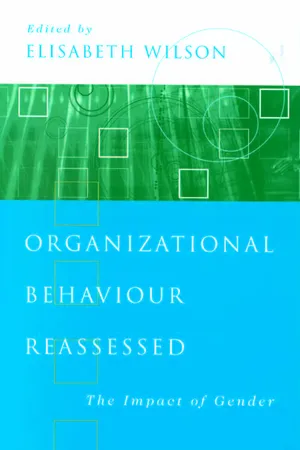Business
Personality at Work
Personality at work refers to the unique set of traits, behaviors, and characteristics that individuals exhibit in a professional environment. It encompasses how individuals interact with colleagues, approach tasks, and handle challenges. Understanding personality at work is crucial for effective team dynamics, communication, and leadership, as it influences work styles, decision-making, and overall organizational culture.
Written by Perlego with AI-assistance
Related key terms
1 of 5
9 Key excerpts on "Personality at Work"
- eBook - PDF
- John R. Schermerhorn, Jr., Daniel G. Bachrach, Barry Wright(Authors)
- 2020(Publication Date)
- Wiley(Publisher)
Perhaps you have been part of conversations like these: “I can’t give him that job; with a personality like that there’s no way he can work with customers.” “Put Shanice on the project—her personality is perfect for the intensity that we expect from the team.” “Olga should present our team’s proposal—she’s got a really outgo- ing personality.” We use the term personality in management to describe the profile of enduring characteristics that makes each of us unique as an individual. No one can doubt that an individual’s personality can influence how she or he behaves and how that behaviour is regarded by others. The implications of person- ality extend from how we face problems and pursue tasks, to how we handle relationships with everyone, whether family, friends, or co-workers. Big Five Personality Dimensions Although there are many different personality traits, some of the most widely recognized are a short list of five that are especially significant in the workplace. Known as the Big Five, 15 these personality dimensions are: 1. Extraversion—the degree to which someone is outgoing, sociable, and assertive. An extravert is comfortable and confident in interpersonal relationships; an introvert is more withdrawn and reserved. 2. Agreeableness—the degree to which someone is good- natured, cooperative, and trusting. An agreeable person gets along well with others; a disagreeable person is a source of conflict and discomfort for others. 3. Conscientiousness—the degree to which someone is responsible, dependable, and careful. A conscientious per- son focuses on what can be accomplished and meets com- mitments; a person who lacks conscientiousness is careless, often trying to do too much and failing, or doing little. 4. Emotional stability—the degree to which someone is relaxed, secure, and generally unworried. A person who is emotionally stable is calm and confident; a person lacking in emotional stability is anxious, nervous, and tense. - eBook - ePub
- James Skinner, Bob Stewart(Authors)
- 2017(Publication Date)
- Routledge(Publisher)
The workplace exposes everyone’s personality. This is because working in an organizational setting demands frequent interaction with other employees, and the exchanges that follow are in part shaped by each individual’s personality. Sometimes dealing with workplace personalities can present a bigger challenge than the work itself. Interpersonal disputes and tensions are often explained by problems resulting from a ‘personality clash’.So, what exactly is personality? It is often associated with terms like ‘temperament’, ‘disposition’ and ‘character’, and thus says something about the ways in which individuals present themselves to others in different social situations. Personality thus has a lot to do with the visible aspect of someone’s character. Additionally, personality is more than exhibiting a specific trait; rather, it is about the embodiment of a collection of qualities. Overall then, personality can be broadly described as the organized pattern of behavioural characteristics of individuals, being the sum total of their physical, mental, emotional and social dispositions.Understanding one’s own personality, and the personality of others, can assist people to make sense of why their co-workers behave the way they do. This can allow us not only to accommodate the eccentricities and foibles of others – we become more tolerant – but also alerts us to the possibilities of using these differences to approach tasks, problems and projects in diverse and creative ways. It is also important to understand that people do not choose their personality: part of it is laid down at birth, while other parts of it are shaped by a multitude of childhood and adolescent experiences, some of which will be highly rewarding, and some of which will be difficult and occasionally traumatic. - eBook - PDF
Organizational Behaviour Reassessed
The Impact of Gender
- Elisabeth M Wilson(Author)
- 2000(Publication Date)
- SAGE Publications Ltd(Publisher)
Personality is the combination of stable physical and mental characteristics that make up an individual's identity and give consistency to the person's behaviour (Weiss, 1996: 30). An individual's personality is the combination of psychological traits we use to classify that person (Robbins, 1992: 31). Personality is manifested in the behaviour, manners and attitudes of individuals. Personality theory is a field of science that has to do with the search for those attributes of people which are relatively enduring and which help define some important aspect of their individual identities (Hosking and Morley, 1991: 7). Organizational Behaviour Reassessed 18 The idea that personality characteristics are stable, and the idea of individual identity that they support, seems to offer a common ground for these definitions. Gender is an integral part of individual identity. It can also be said that gender constitutes identity and embodies it. Bodies always convey a gendered identity, even if sometimes a false one, as is the case for transsexual identities. Gender identities are formed and moulded in public and in private, in society, in culture, in families, at work and in social life. The patterns and processes of socialization are not constant and rigid, but vary over time, culture and other factors. The reasons why personality has always been popular in the organizational behaviour literature are manifold. One reason might be that managers benefit from personality theories, particularly on those that can be measured, tested and used for feedback to improve, adjust, train and make decisions about employee behaviour. Performance is, after all, based on behaviour. Managers are interested in personal dynamics as they affect behaviour and therefore performance (Weiss, 1996). Personality assessments are most commonly made through self-report questionnaires, projective tests and behavioural measures. - Philip J. Corr, Gerald Matthews(Authors)
- 2009(Publication Date)
- Cambridge University Press(Publisher)
Personality and teamworking The relationship between personality and teamworking is an area that is gathering momentum in the IO psychology literature. One line of enquiry has been to investigate the relationship of personality with team performance. For example, Barrick, Stewart, Neubert and Mount (1998), in a study of fifty-one work teams, examined the relationships among team composition (ability and person- ality), team processes (social cohesion), and team outcomes (team viability and performance). Results found that teams higher in Conscientiousness, Agreeableness, Extraversion, and lower in Neuroticism, were rated higher by supervisors in terms of team performance. Meanwhile, Morgeson, Reider and Campion (2005) found that Conscientiousness, Extraversion, Agreeableness and Emotional Stability all predicted contextual performance, while Conscientiousness, Extraversion and Personality at Work 755 teamwork knowledge incrementally predicted contextual performance (.48), in highly interdependent teams within a manufacturing organization. More recently, Bennett and Burch (2007) investigated the relationship between team leader personality and team climate in a study of 63 four-person interde- pendent emergency service teams, with results revealing team leader Extraversion to be positively related with team climate scale scores of ‘Participative Safety’ and ‘Support for Innovation’, as measured by the Team Climate Inventory (TCI) (Anderson and West 1998). These results suggest Extraversion, not surprisingly, to be an important dimension in relation to teamworking. ‘Dark side’ of Personality at Work In addition to the interest in ‘normal’ personality and work performance, there is a growing interest in the ‘dark side’ of personality in the workplace (that is, more negatively connotated traits and behaviours), with much of this pertaining to the leadership literature.- eBook - ePub
- James L. Farr, Nancy T. Tippins, James L. Farr, Nancy T. Tippins(Authors)
- 2017(Publication Date)
- Routledge(Publisher)
process by which personality affects job performance.In terms of design, researchers have found that using supervisor, coworker, and customer ratings of employee personality (rather than self-ratings alone) increases the total explained variance in performance ratings by an additional 11–20% (Mount, Barrick, & Strauss, 1994). In addition, when job performance is measured using more specific versus general job criteria, personality characteristics appear to more accurately predict job performance ratings (Hogan & Holland, 2003). Regarding personality measurement, Hunthausen et al. (2003) studied entry-level customer service managers at a major airline and found that using an “at-work” frame of reference (i.e., asking respondents to think about how they behave at work when responding to survey questions) resulted in stronger relationships between two dimensions of the Big Five (extraversion and openness to experience) and supervisory performance ratings (controlling for cognitive ability). Huang and Ryan (2011) found meaningful variation in personality states within individuals over time, suggesting that workers’ abilities to adapt their personality to the situational demands may be more important than having a certain “average” or stable level of any given characteristic. Finally, Grant (2013) found evidence of a curvilinear relationship between extraversion and sales revenue among call-center representatives, observing that performance gains associated with extraversion begin to decline at higher levels of this personality dimension. Such findings suggest that the optimum level of certain personality characteristics may vary depending on the focal occupation and corresponding job demands.Narrow Personality Traits
Although a large amount of research centers on broad measures of personality such as the Big Five, researchers have also examined relationships between specific or narrow traits of personality and job performance. In general, there is debate concerning whether broad or narrow measures of personality are best for predicting job performance. Although some contend that broad measures are more successful at predicting overall performance (Ones & Viswesvaran, 1996), others maintain that narrow measures account for more variance and argue that researchers should use narrow personality traits to predict specific aspects of job performance (Schneider, Hough, & Dunnette, 1996). In doing so, criterion-related validity may be improved because the predictors (traits) are more closely attuned to the criterion (job performance). - eBook - PDF
- David Pendleton, Adrian F. Furnham(Authors)
- 2016(Publication Date)
- Palgrave Macmillan(Publisher)
Of all the ‘Big Five’ factors that seem most logically and consistently related to all aspects of work behaviour it is Conscientiousness (posi- tively) and Neuroticism (negatively) that exercise the most powerful effects. Yet most of us would recognise that specific characteristics tend to combine with others to produce more complex effects. An anxious intro- vert might be quite different from a stable and relaxed introvert; someone who is altruistic and diligent might have a quite different impact in the workplace from someone who, though diligent, is unconcerned for other people. There is good research evidence for this also. Ones and her col- leagues (2005) have argued from their meta-analyses that combinations of personality characteristics can predict outcomes in the workplace more powerfully than single characteristics. When those traits that do have pre- dictive validity are combined with others, the results are impressive push- ing validities to over 40. This is a very important and often overlooked point. Specific personality characteristics tend to be elements in a more complex picture and a personality is a combination of traits that interact. This is the significance of a more complete description of personality such as a personality profile. Specific personality characteristics tend to be elements in a more complex picture and a personality is a combination of traits that interact. Barrick and Mount (2005) say personality matters at work for many reasons and provide sensible guidance on how to think about the evi- dence gleaned so far on these matters. They urge us to think about traits intelligently accepting that Neuroticism is only likely to predict negative behaviours (such as absenteeism) rather than positive behaviours such as productivity. They also recognise that there are sound measures of per- sonality and those that are unsound from a technical point of view and also that there are good and poor indicators of workplace success. - eBook - PDF
Human Safety and Risk Management
A Psychological Perspective, Third Edition
- A. Ian Glendon, Sharon Clarke(Authors)
- 2018(Publication Date)
- CRC Press(Publisher)
207 chapter seven Personality impacts A person is like some other people, all other people and no other person. After Kluckholn and Murray (1953) In psychology, the individual is the prime focus of attention; the ways in which we are similar to, and differ from, other people and what makes each of us unique is a particular blend of measurable individual characteristics. If we can better understand the nature of these characteristics (or traits or dimensions) and link them with particular job require-ments, then we should be better able to predict job performance, including safety require-ments, and we might also be better able to select for, and tailor training toward, those individual characteristics. Thus, understanding relevant aspects of personality should help in managing workplace safety. Evolution has equipped our species with a precious natural resource: diversity. This diversity enables, even requires us, to perceive risk differently, and to be predisposed to differential risk taking. Denying our diversity, or assuming that the same social and eco-nomic laws govern us all, would be to deny a vital aspect of our humanity. This diversity cannot be regulated for, nor can it be readily assessed in a general sense, although this chapter discusses many attempts to measure the diversity that exists between individuals and, more problematically, some of the ways that have been prescribed to address it. Personality can be defined as those relatively stable and enduring features of an indi-vidual that distinguish each of us from other people, and that forms the basis of our pre-dictions of other people’s behavior (Pervin & John, 1999). For example, having consistently observed a person as being a safe driver, we may conclude that his/her personality encap-sulates such a quality. Although psychology incorporates a number of approaches to per-sonality, the dominant one focuses on traits. Traits are dimensions of personality along which each individual is located. - eBook - PDF
- Mary Uhl-Bien, John R. Schermerhorn, Jr., Richard N. Osborn(Authors)
- 2013(Publication Date)
- Wiley(Publisher)
• Social identity theory suggests that many forms of discrimination are subtle but power- ful, and may occur in subconscious psychological processes that individuals of out- groups perceive in the workplace. • Organizations can value diversity by promoting cultures of inclusion that implement policies and practices to help create a more equitable and opportunity-based environment for all. What is personality? • Personality captures the overall profile, or combination of characteristics, that repre- sents the unique nature of an individual as that individual interacts with others. • Personality is determined by both heredity and environment; across all personality characteristics, the mix of heredity and environment is about 50–50. The Big Five personality traits are extraversion, agreeableness, conscientiousness, emotional stability, and openness to experience. • A useful personality framework consists of social traits, personal conception traits, emotional adjustment traits, and personality dynamics, where each category repre- sents one or more personality dimensions. How are personality and stress related? • Stress emerges when people experience tensions caused by extraordinary demands, constraints, or opportunities in their jobs. • Personal stressors derive from personality type, needs, and values; they can influence how stressful different situations become for different people. • Work stressors arise from such things as excessive task demands, interpersonal prob- lems, unclear roles, ethical dilemmas, and career disappointments. • Nonwork stress can spill over to affect people at work; nonwork stressors may be traced to family situations, economic difficulties, and personal problems. • Stress can be managed by prevention—such as making adjustments in work and nonwork factors; it can also be dealt with through coping mechanisms and personal wellness—taking steps to maintain a healthy body and mind capable of better withstanding stressful situations. - eBook - PDF
- Arnold B. Bakker(Author)
- 2013(Publication Date)
- Emerald Group Publishing Limited(Publisher)
In line with this model, it is possible that work characteristics may modify an employee’s personality, which, in turn, leads to changes in that person’s occupational well-being. What is more, a direct association between work characteristics and occupational well-being is also possible along with an indirect link via personality, resulting in a partially mediated effect model (Fig. 2f). Personality may also operate as an outcome in relation to work characteristics and occupational well-being, as hypothesized by the outcome model (Fig. 2g); that is, work characteristics may lead to changes in personality both directly and indirectly, when work characteristics lead to changes in occupational well-being, which, in turn, cause changes in employees’ personality. For example, excessive workload might decrease an employee’s well-being; this may then induce a negative change in personality, for example, in terms of lowered self-esteem or efficacy. The final possibility – labeled the direct effect model (Fig. 2h) – assumes that personality and work characteristics each lead independently to changes in occupational well-being. According to this model, employees’ personality is linked to their occupational well-being irrespective of the work character-istics they perceive in their working environment. Next we shall discuss how personality – in line with the mechanisms presented above – has been examined in the context of positive work psychology. Our discussion is based on a literature review of the research on personality and WE. Individual Differences in Occupational Well-being 117 A QUALITATIVE REVIEW OF PERSONALITY AND WORK ENGAGEMENT The personality characteristics reviewed in this chapter have typically been examined in relation to occupational ill-being (e.g., burnout, symptoms) or job attitudes such as job satisfaction.
Index pages curate the most relevant extracts from our library of academic textbooks. They’ve been created using an in-house natural language model (NLM), each adding context and meaning to key research topics.








